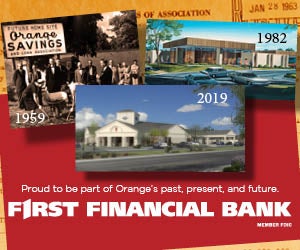Orange was looking busy in 1961
Published 6:06 pm Sunday, April 7, 2019

- First Financial Bank. Here yesterday, here today, here tomorrow
A lot had happened in Orange in 1960 and it was looking like 1961 was going to be busy as well.
Zeto Enterprises had built a home that received national recognition. The home built on Coronado Street had been one of six nationwide that had received an award by the National Association of Home Builders. The home had been featured in the February 3 edition of Life magazine. Erwin Olexa, the architect for Zeto had drawn plans for the home that had received a design award for outstanding design, economical production, imaginative and creative use of new products, planning, and layout concepts.
The Orange Chamber of Commerce Navigation and Waterways Committee was having a series of meetings with the Army Corps of Engineers requesting that the channel from the Neches River conjunction to the I-10 bridge be deepened to a 40 foot depth and a width of 400 feet and that a barge channel be made with a 12 foot minimum depth from the I-10 highway bridge to the Southern Pacific railroad bridge at Echo. They were also asking for a 30 foot deep, 250-foot wide channel be made from the Sabine River to the Highway 87 bridge at Bridge City, and for Adams Bayou be dredged to a deeper depth and widened from the Sabine River to the bridge crossing the bayou at Chemical Row.
The 1961 reference book for the Dun and Bradstreet Houston office showed that there were 652 manufacturers, wholesale and retail outlets in the county as compared to 635 in the area for the same period in 1960. This was a respectable 3 percent increase.
Construction had started late in 1960 on the Gulf States Utility Company’s sixth and newest generation plant. The plant was to have two 220,000 kilowatt generation units. When completed this would be the second largest plant behind the Neches Station in Beaumont.
Consolidated Shipyard had become the American Bridge Division of United States Steel Corporation. Construction of two mammoth underwater highway tunnels was underway. The Thimble Shoal Tunnel was to be 5,378 feet long and the Baltimore Channel Tunnel would be 5, 450 feet long. The two tunnels would require 26,000 tons of steel. The tunnels would be built in 300-foot sections. They would be towed 1700 miles to become part of the highway linking the Eastern Shore area of Virginia to the Hampton Roads-Norfolk area. The project was slated to be completed in 1962.
Two new shopping centers opened in Orange. The MacArthur Shopping Center had 14 stores and the Easttown Shopping Center had four new stores.
The 1961 basketball season was underway. In District 11 AAAA Orange was in third place. In District 10 AAA Vidor was ranked sixth. District 24 AA showed Little Cypress at second place. In District 23 AA West Orange was in second place, Bridge City was in the fifth-place slot. Orangefield was fifth in District 25 A. Deweyville was third place in District 70 B.
For sale in Orange sports stores were the newest high powered Evinrude outboard motor. The 75 horsepower Starflite V4.
The Orange Jaycees were planning the upcoming summer rodeo. The 1960 rodeo had been very successful with the star of the Wanted Dead or Alive TV show, Steve McQueen, as the headline performer. The Jaycees were hoping for another star performer in 1961 and hoping he would be a bit more “manageable” than McQueen had been.
In 1960 Orange County Port activities had shown a 56.26 percent increase over the prior year.
Bridge City had been the fastest growing community in Orange County in 1960.
The City of Pine Forest located north of Vidor consisted of an area of 2 ½ miles square and 190 homes. It was the smallest incorporated area in Texas.
By the end of 1960, Spencer Chemical Company on Chemical Row had completed their third expansion in a six-year period.
Twelve young ladies had entered the Miss Orange contest for 1961. The winner of this contest would be on the road to Miss America.
“And now you know”





